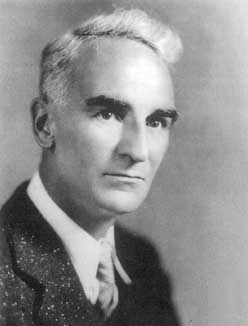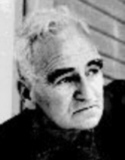Tales of Statisticians
Eric Temple Bell
7 Feb 1883 - 20 Dec 1960Bell was no statistician; rather, a number theorist. He was and remains one of the great mathematical statesmen. His book Men of Mathematics has inspired scores to take up a mathematical career, and revealed to uncounted thousands what a mathematical life is all about in the first place.
His own early life was a mystery until parts of it were unraveled by Constance Reid. He was born in Aberdeen in 1883, spent his early years in London, and came to America at the age of nineteen in 1903. He finished college at Stanford in 1904, and went on to the University of Washington (MS 1907) and Columbia (PhD 1912). He taught at the University of Washington from that year until 1926. His contribution to statistics in this period was to encourage Harold Hotelling to switch from journalism to math (Hotelling named his son after Bell). In his own researches at this time, Bell produced significant results in number theory, including Diophantine analysis: equations whose solutions are limited to whole numbers. The Bell numbers (1, 1, 2, 5, 15, 52, and so on), a series of whole numbers arising in the theory of partitions, were first investigated by him, and are named for him. His 1921 memoir Arithmetical Paraphrases won him the prestigious Bôcher Prize (jointly with Solomon Lefschetz) in 1924.

In that year he began a second life as a science fiction writer, under the pen name John Taine (his only son, born in 1917, had been named Taine Bell). In all, he produced twelve novels and several stories between 1924 and 1954. In 1926, having earlier declined offers from Chicago and Columbia, he joined the faculty of the California Institute of Technology, where he became a distinctive and even eccentric figure, and had much to do with building up the quality of the mathematics faculty. His next mathematical publication was the comprehensive survey Algebraic Arithmetic (1927). His enduring masterpiece of popularization, Men of Mathematics, came somewhat later, in 1937. The more technically advanced Development of Mathematics (1940) had a comparable appeal and influence for professional and preprofessional readers. His gift for explanation and his fascination with the integers are both evident in The Magic of Numbers (1946), a book on Pythagoras and the number mysticism of the Pythagorean school.

Bell retired from CalTech in 1951, and died at the age of 77 in 1960. With the assistance of D H Lehmer, who had provided the otherwise missing final chapter, he had just completed a book entitled The Last Problem. It was about Fermat, to whom, and to whose tantalizingly unproved Last Theorem, a chapter of Men of Mathematics had already been devoted. Bell's conviction at the time, that Fermat's unmatched insight into the character of numbers did not mislead him as to the existence of a proof, was vindicated recently when a proof was finally found.
Bell's infectious love of number, his sense of the large sweep of mathematical history, and his generous anger at the fools and poopheads who all too densely populate that history, are his great legacy to posterity.
Postscript 2003
The above notice happened to catch the eye of ETB's grandson, Lyle Bell, the only son of Taine Bell, who commented that ETB "would have loved the last paragraph." We asked Lyle what ETB was like as a grandfather. Here, with his permission, is his answer, along with notes on ETB's last days. We should add by way of clarification that "Romps" was ETB's name for himself, and "Toby" was his name for his wife Jessie.
"E T Bell, known as Pop Romps to me (he refused to be called Grandpa), brings back some interesting and humorous memories. You asked how he was as a grandfather. The answer is that he tolerated me and my two sisters reasonably well. He wasn't the type to sit his grandkids on his lap. I believe he was pretty fond of Laurie, the older of the two (both younger than me). From what I know, he always took more of a liking to females than males (that reminds me of the fact that he apparently didn't want any children, his wife "tricked" him into it, and he was unhappy that he had a boy rather than a girl). We visited him in Pasadena maybe two or three times that I can remember. I remember a modest home with walls full of books and lots of cigar smoke. He had quite a large garden and a really neat study in a small structure in the middle of the garden. He visited us in Watsonville a few times when he was healthy. I remember one time when I felt I really hadn't spent any time with him, and asked to stay home from school for the day. We sat in the living room together, no doubt awkwardly for him. I don't remember anything about the visit except that I was just learning how to multiply at the time, and he asked me to figure out what 7 x 7 is. It took me a while to get 49, and to this day those are my favorite numbers.
Some time in late 1958 or early 1959 he was still living in Pasadena when he fell off a chair he was standing on to change a light bulb and broke his arm. My parents (both physicians) decided to bring him up to the Watsonville Hospital where they could keep an eye on him while he recovered. Then they decided he wasn't fit to live by himself and that he should live in a rest home in Watsonville. When they announced their plans, he made it abundantly clear that he had no intention of living with a bunch of old farts. He would stay right where he was, end of discussion! He was moved to a private room close to the nurses' station. He flirted with the nurses, smoked cigars, filled his room with books, worked on The Last Problem, and drank Scotch. He was quite popular with the nurses. On one occasion he caught his bed on fire as a result of careless smoking. He was reprimanded by the hospital administration and told that he could not smoke without a nurse being present. He said "Great, I will enjoy having more company!" and continued to smoke when he wanted to.
I was in the sixth grade when he passed away. As I was getting on my bicycle to ride to school, my Mom came out to tell me that Pop Romps had died the night before. She told me to go to school. That evening I remember having a short, awkward conversation with my Dad and telling him I was sorry that Pop Romps had died. There was NO other discussion or acknowledgement of his death within the family at the time. There is no way my Dad would get involved with any kind of service because his religious upbringing was totally non-existent. When he was in the third grade, he had asked his parents what the big plus sign on the building was for!
When I was in college, it occurred to me that I never knew what happened after Pop Romps died. I asked my Mom, and she told me he was still in her closet. He had left very specific instructions that he was to be cremated and his ashes spread at the base of the rock on a hillside in Yreka, California, where he had proposed to his wife, Toby. He had spread her ashes there. He left directions and a photo of the location. Yreka is in the northernmost part of California. My parents did not have an occasion to go up there and didn't want to make a special trip, so he stayed in the closet. They made the trip in the early 1970's. They arrived early on a foggy morning and found the rock near a swing set in the back yard of a nice home. Dad hopped the fence and did the deed. The ashes were very light in color and contained bone fragments. They didn't exactly blend with the green grass, which was covered with dew. He tried to work them into the grass with his feet and just made matters worse. He got back in the car and drove out of town fast before somebody spotted the rather suspicious activity. Pop Romps was no doubt reveling through the whole ordeal."
Statistics is Copyright © 2001- by E Bruce Brooks
14 Sept 2005 / Contact The Project / Exit to Statistics Page